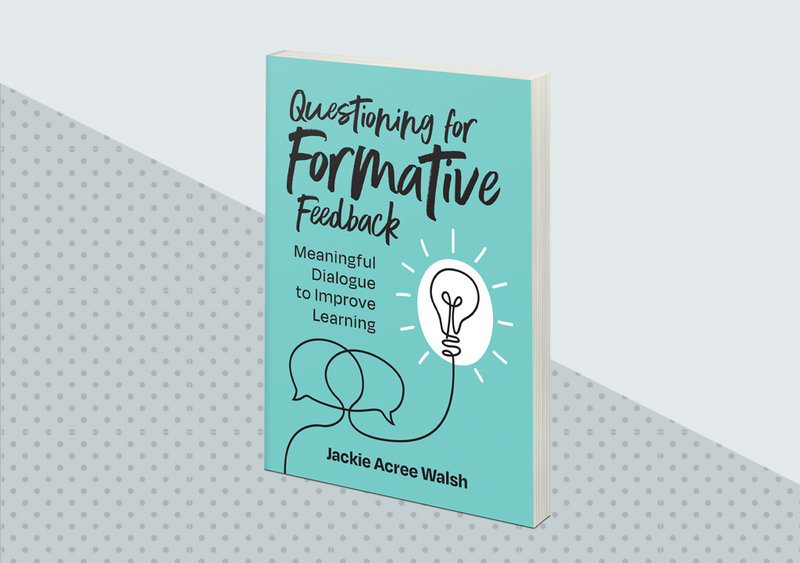At some point in your teaching career, you’ve likely been in a scenario where you’ve asked students, “Who knows the answer to the question on the board?” and waited in agony at the palpable silence that ensues. They know the answer, you think. Not a few seconds later, you give up, and answer the question yourself (there’s too much material to cover, after all).
But this hasty move eliminates a vital aspect of teaching: the opportunity to receive quality formative feedback. For feedback expert Jackie Acree Walsh, formative feedback is both information a learner uses to confirm, correct, or extend knowledge and information the teacher uses to determine student progress toward a learning goal. According to Walsh, a simple change in language, and a few purposeful pauses before and after a student response, can go a long way toward igniting student thinking and spurring greater feedback from student to teacher. After all, research demonstrates questioning and feedback each have the potential to increase students’ cognitive, social, and emotional involvement in their learning.
Small Shifts in Language
For teachers to receive better formative feedback from their students, the process starts by posing effective questions. Specifically, educators can retool how they frame questions and which words they use. Asking students for a response, instead of a straight answer, is one such way. “Think about what might happen if instead of asking for an answer to a question,” Walsh said during a recent ASCD webinar, “you ask students for a response.”
This subtle change in word choice leaves necessary space for students to respond even if they don’t know the exact answer. But simply changing the framing of a question isn’t enough to squeeze the most formative feedback from a questioning session; Walsh recommends another component as integral to questioning for formative feedback—think time.
Why Think Time?
Think time, or wait time, is the period of silence between the time a question is asked and the time when one or more students responds to that question. The next phase of think time is the same period of silence after a student responds.
In 1972, Mary Budd Rowe published data noting that allowing a minimum of three to five seconds of wait time before and after a student’s response produces several positive changes in the classroom. There are increases to the length of students’ response, student confidence, and to the number of unsolicited responses.
Walsh agrees, even noting how the pause can help educators: “Those pauses provide opportunities for us as teachers to think.”
Think Time 1
Students need time to understand the meaning of the question being asked. “They need to translate it into their own words,” Walsh said to webinar attendees. “And then they need to go to that long-term memory and make connections between the question and what they think they know about the topic.”
Finally, students bring that information to short-term memory and perhaps even rehearse a response. So, how can educators get the most out of this time before a student responds (Think Time 1)? A good way is to teach students to use the following to become better practitioners of Think Time 1 (See Figure 1.)
Figure 1: Think Time 1
Walsh recommends explicitly teaching how to appropriately use think time to students during the first two to three weeks of the school year. “It can be invaluable,” she noted, “and it makes a good wall chart.” For more on how to teach students to use Think Time, check out Walsh’s Quick Reference Guide, “Questioning Strategies to Activate Student Thinking” (ASCD, 2022).
Think Time 2
Like Think Time 1, Think Time 2, the pause after the student response, allows the teacher to think. Specifically, the teacher can use Think Time 2 to interpret the student’s response, assess relative correctness of the response, and decide on a follow-up move.
This pause can, for example, prompt the teacher to stop and perform a mini-lesson before moving on if the student’s response suggests a need for review. So, how can educators make sure students are getting the most out of the pause after a student’s response? It starts by teaching students to be active listeners and thinkers. They must have time to process what was said, compare their answer to the speakers’, and prepare to defend their response (See Figure 2.)
Figure 2: Think Time 2 Responders
As for the student responders, they too must pause to calculate whether they’ve communicated clearly, if they want to change their response, and if they have anything to add to their response (See Figure 3.)
Figure 3: Think Time 2 Listeners
“The research shows Think Time 2 results in students responding at a higher level of thinking, providing lengthier responses, and making more connections,” Walsh said. Like Think Time 1, if students know how to properly attune for these pauses, these seconds for thinking can become an invaluable classroom resource for both teachers and students.
The Value of Think Time
During the webinar, Walsh showed a video of high school students discussing the impact of Think Time 1 and 2. (Access to this video, along with many others, comes with the purchase of Walsh’s book Questioning for Formative Feedback). One student noted how the think time process became “more natural” the more they actively practiced it. Another student compared the experience in their class to other classes that don’t practice think time: “Most teachers either tell you you’re right or wrong immediately, but when Ms. Bugsby stops, you’re still thinking for yourself and it’s not the teacher who is correcting.”
The full benefits of the process, however, can only be realized if teachers give students the opportunity to actively reflect on their process as responders and listeners to a question. Teaching Think Time 1 and 2 in the classroom explicitly will further growth and learning. “As teachers, we need to make students accountable for this listening by putting structures in place that will give them the opportunity to express their thoughts,” Walsh concluded.
Questioning for Formative Feedback: Meaningful Dialogue to Improve Learning
When used effectively, quality questions and student dialogue result in self-regulated learners and formative feedback that reveals progress toward learning goals.









